 | |||
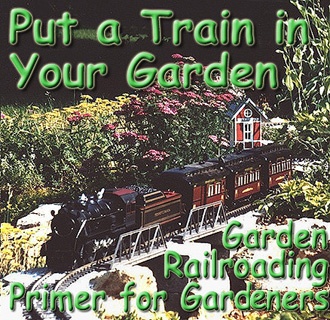 |
 |  | |
 |  | ||
 |  | ||
 |  | ||
 |  | ||
 | |||
 |
 |  | |
 |  | ||
 |  | ||
 |  | ||
 |  | ||
Written by Paul D. Race for Family Garden Trains(tm)
 |
 If you love your garden, and you've thought about adding a train to it, this article is for you. Chances are you've seen garden railroads, on television, in botanical gardens, or even in neighborhood back yards. And you rightly think that having a train running somewhere in your garden would add interest. But when you tried to learn more, you found out that “train people” talk in codes like "R-3 turnout," and "wide-radius floating track" and "four-six-oh." Don't worry, you don't have to know all of this stuff to add a fun and attractive railroad feature to your garden (any more than they have to be conifer experts to get a bunch of Dwarf Alberta Spruce in the ground and kid them along from year to year).
If you love your garden, and you've thought about adding a train to it, this article is for you. Chances are you've seen garden railroads, on television, in botanical gardens, or even in neighborhood back yards. And you rightly think that having a train running somewhere in your garden would add interest. But when you tried to learn more, you found out that “train people” talk in codes like "R-3 turnout," and "wide-radius floating track" and "four-six-oh." Don't worry, you don't have to know all of this stuff to add a fun and attractive railroad feature to your garden (any more than they have to be conifer experts to get a bunch of Dwarf Alberta Spruce in the ground and kid them along from year to year).
In fact, if you've already accumulated some garden design and landscaping skills, you're ahead of many folks who know a lot about trains, but who barely know which end of the shovel goes in the ground. That said, this article is intended to fill in some of the gaps in what you do know, and to help you make good choices in your plans and purchases.
The following questions are answered in this article: (If you jump to any of these, your browser's "back button" should bring you back to the top of the page.)

Not really. You need:
This is actually an easier decision than you might think. Although there are many choices and products, the first thing you should know is that almost all garden trains use essentially the same track. So even if you buy a train you get tired of later on (or that the kids break), you don't have to do the installation part all over again.
Garden trains come in two main categories: Standard Gauge and Narrow Gauge. You don't even have to know what that means. All you need to know is what kind of "look" you want for your garden railroad:
Note: Don't spend an inordinate amount of time making this decision. Your starter set is just to get you started, period. You can always change the kind of trains you run and keep your starter set to use around the Christmas tree or to let the kids run, if you want. But if you never buy a starter set, you'll pretty much never get started.
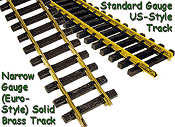 So when you're pricing your starter set, mentally add $80-120 for a loop and a few extra pieces of track to use outside. The kind of track you need depends on what kind of trains you want to run. The AristoCraft company makes both kinds:
So when you're pricing your starter set, mentally add $80-120 for a loop and a few extra pieces of track to use outside. The kind of track you need depends on what kind of trains you want to run. The AristoCraft company makes both kinds:
For more information on track planning, please check out the Family Garden Trains Primer article Planning Your Garden Railroad for High Reliability. For more information on track choices, check out the article on Garden Railroad Track Options.
| None, really. Although most garden railroaders buy and assemble kits that are made to be used outside, that's not necessary. Some folks starting out are just as happy with the hand-painted wooden birdhouses they sell at WalMart. But if you want something more realistic and more durable, consider AristoCraft's line of assembled and mostly-assembled buildings. AristoCraft's "built-up" stations are especially good buys for products that will give you both instant gratification and years of enjoyment. | 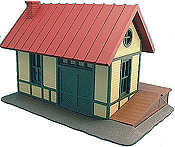 | 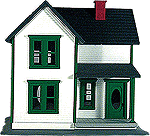 |
If you want to buy and assemble some kits later, of course, you may. In fact, that's how many garden railroaders stay "active" in the winter. But the point is, you don't have to spend time your first year gluing things together to get a working, attractive railroad, complete with a train and a station or two installed in your garden,
 The real question is, what kinds of plants do you want to use? Many "train people" like to think of their garden railways as outdoor model railroads. They prefer plants whose details are in scale, or close to scale with the trains, so their scenery is as "realistic" as possible - dwarf conifers, miniature sedums, creeping thymes, etc. Some are satisfied if the overall size of the plants doesn't detract from or overwhelm the trains - Pachysandra, Threadleaf Coreopsis, bedding plants, etc. Or you may want to choose the third option - leave your Calla lilies right where they are, and treat your train as just one element (and not the main element) in a flower garden.
The real question is, what kinds of plants do you want to use? Many "train people" like to think of their garden railways as outdoor model railroads. They prefer plants whose details are in scale, or close to scale with the trains, so their scenery is as "realistic" as possible - dwarf conifers, miniature sedums, creeping thymes, etc. Some are satisfied if the overall size of the plants doesn't detract from or overwhelm the trains - Pachysandra, Threadleaf Coreopsis, bedding plants, etc. Or you may want to choose the third option - leave your Calla lilies right where they are, and treat your train as just one element (and not the main element) in a flower garden.
If you want to try the "scale plants" route, you'll find a few visits to area garden railroads very helpful. Not only will you see what plants seem to work in your area, you may be offered some useful "starts." Don't count on the "train people" knowing the right names for their plants, though. I was excited when I had luck with "Stubby Fingers" Sedum, a stonecrop that looks like a tiny jade plant. No one in the club had heard of it. But it turned out later that most of them had it - they just didn't know what to call it besides "That stuff Eloise found by the side of the road in Turpin" or some such. Many Garden Railroaders who start out as "train people" actually become decent gardeners (or at least their spouses do). But in the meantime, there's nothing wrong with learning or getting useful plant starts from people in your area who have accumulated their knowledge of plants from trial-and-error.
If you want to dabble with "scale" and "near-scale" plantings near your train, you may find the plant articles on the The Family Garden Trains Primer page helpful.
 You'll also need to get low-voltage power out to the tracks somehow, but if you have already installed garden lighting or a pond pump, this shouldn't be too difficult for you. The little power pack that comes with your starter set is usually strong enough to handle a small railroad, providing your track has good connections (something AristoCraft track helps with). However, unlike your trains, it can't be left outside in the rain (or even the dew). So, for now, plan on taking it out on days you want to run, unless you have a place where you can leave it under roof close to the railroad. You also must use a GFI (Ground Fault Interrupt) protector on the circuit into which you plug your power pack. The Family Garden Trains articles Electrical Safety and Garden Railroading and Large Scale Power and Control contain much more information about options you may find helpful.
You'll also need to get low-voltage power out to the tracks somehow, but if you have already installed garden lighting or a pond pump, this shouldn't be too difficult for you. The little power pack that comes with your starter set is usually strong enough to handle a small railroad, providing your track has good connections (something AristoCraft track helps with). However, unlike your trains, it can't be left outside in the rain (or even the dew). So, for now, plan on taking it out on days you want to run, unless you have a place where you can leave it under roof close to the railroad. You also must use a GFI (Ground Fault Interrupt) protector on the circuit into which you plug your power pack. The Family Garden Trains articles Electrical Safety and Garden Railroading and Large Scale Power and Control contain much more information about options you may find helpful.
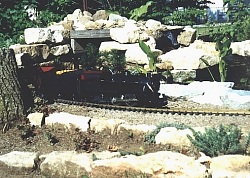
The Family Garden Trains Primer page has several articles on construction topics. But if you've done any landscaping at all, chances are you'll think of something that works especially well for you. In addition, if you start with a fairly small railroad, until you get the "hang of things," you won't have much, if any rework to do if you later come up with a better way of installing something.
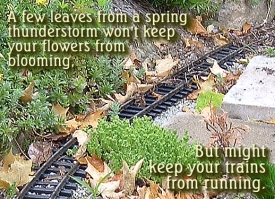 Track Maintenance - Don't let the word "maintenance" scare you. Actually, unless your track is under a rack of bird feeders or conifers that dump loads of sap on it, you'll only need to clean the top rail a couple of times a season, and occasionally clean up a patch where bug juice or something has gummed it up (Lots of folks use Scotchbrite pads for this). But you do need to keep plants, leaves, twigs, plant runners, etc., off the track for the trains to run. Some gardeners who put trains into established shade gardens noticed how much "bigger" a problem they had with leaves and twigs than they had noticed before. Generally, once a garden railroad is up and running in the spring, it only takes a few minutes of "policing the area" before it's ready to go on any particular day, so it's not a huge hassle. But if this minor caution helps you think about the kind of railroad you want to have and how high off the ground you want to put the track, that's a good thing.
Track Maintenance - Don't let the word "maintenance" scare you. Actually, unless your track is under a rack of bird feeders or conifers that dump loads of sap on it, you'll only need to clean the top rail a couple of times a season, and occasionally clean up a patch where bug juice or something has gummed it up (Lots of folks use Scotchbrite pads for this). But you do need to keep plants, leaves, twigs, plant runners, etc., off the track for the trains to run. Some gardeners who put trains into established shade gardens noticed how much "bigger" a problem they had with leaves and twigs than they had noticed before. Generally, once a garden railroad is up and running in the spring, it only takes a few minutes of "policing the area" before it's ready to go on any particular day, so it's not a huge hassle. But if this minor caution helps you think about the kind of railroad you want to have and how high off the ground you want to put the track, that's a good thing.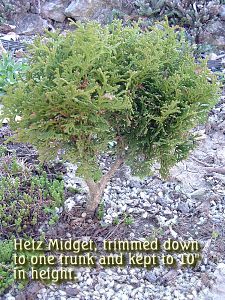
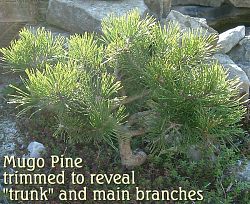 Plant Growth - A bigger difference is the kinds of plants you want near your trains, and how fast or slow you want them to grow. Few successful gardeners are satisfied if a plant they bring home stays exactly the same size year after year. But most garden railroaders are quite happy with that. Not to say that we are Bonsaii experts (would that we were), only that we strive for some of the same effects. Some garden railroaders, true, know or learn all about preparing the soil, and testing the ph, and so on. But you'll seldom see fertilizer play a huge part in our plans. Some of us have gotten adept at creative trimming. In fact, most of my Dwarf Alberta Spruce are smaller and skinnier now than when I brought them home years ago. I've also had luck with landscaping plants that are supposed to get big and bushy, such as Mugo pine and small globe Aborvitaes. Generally I trim each conifer back once in the early spring and once in the early fall. (For most trimming jobs, I focus on eliminating redundant branches so that the tree's "trunk" and main branches show up better. When trimming a tree back to keep it to a smaller size, I also avoid cutting any branch so far back that only a few needles remain - a good way to kill a branch.) And I never fertilize, with the occasional exception of a new plant or new start that doesn't look like it's going to make it otherwise. The mugo pine shown above was planted in 1998, and with creative trimming and neglect, has been kept to about 1/2" of growth per year. I'll confess, I have killed some trees (one reason I buy them as cheaply as possible) but that's still better than having to rotate my stock every few years, digging up everything in the process, as the "kinder" gardeners do.
Plant Growth - A bigger difference is the kinds of plants you want near your trains, and how fast or slow you want them to grow. Few successful gardeners are satisfied if a plant they bring home stays exactly the same size year after year. But most garden railroaders are quite happy with that. Not to say that we are Bonsaii experts (would that we were), only that we strive for some of the same effects. Some garden railroaders, true, know or learn all about preparing the soil, and testing the ph, and so on. But you'll seldom see fertilizer play a huge part in our plans. Some of us have gotten adept at creative trimming. In fact, most of my Dwarf Alberta Spruce are smaller and skinnier now than when I brought them home years ago. I've also had luck with landscaping plants that are supposed to get big and bushy, such as Mugo pine and small globe Aborvitaes. Generally I trim each conifer back once in the early spring and once in the early fall. (For most trimming jobs, I focus on eliminating redundant branches so that the tree's "trunk" and main branches show up better. When trimming a tree back to keep it to a smaller size, I also avoid cutting any branch so far back that only a few needles remain - a good way to kill a branch.) And I never fertilize, with the occasional exception of a new plant or new start that doesn't look like it's going to make it otherwise. The mugo pine shown above was planted in 1998, and with creative trimming and neglect, has been kept to about 1/2" of growth per year. I'll confess, I have killed some trees (one reason I buy them as cheaply as possible) but that's still better than having to rotate my stock every few years, digging up everything in the process, as the "kinder" gardeners do.
This is one area of gardening in which you might benefit from seeing what people in your area are using. Here in Ohio, you see a great deal of Dwarf Alberta Spruce and it's daintier (and more expensive) cousin, Jean's Dilley. I've done some experimenting with other plants (such as Hetz Midget and Tom Thumb Cottoneaster) to vary my "treeforms." In other parts of the country, other slow-growing and miniature trees and shrubs do very well.
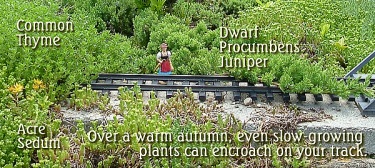 Plants that Spread by Runners - Related to the need to regularly clear your tracks of fallen leaves, twigs, etc., you need to consider plantings that won't constantly be growing over your track. The worst planting mistake most beginning garden railroaders make is to try incorporate groundcovers that spread by sending up runners six inches or more away from the original plant. They may work fine in your flowerbed, but grow like Kudzu in your railroad. My worst bout in this regard was with an Ajuga (Bugleweed), which behaved itself very nicely in my sister's flowerbed, where it was controlled by physical barriers. In my garden, the same plant's runners took only a few weeks to leapfrog track, accessories, and other plants, to establish a dozen starts far from the area I wanted it to fill, at the expense of several slow-growing plants (Elfin Thyme, etc.) that I had been coaxing along. My Groundcover 101 article contains more information on useful groundcovers, including what to avoid. The bright side of this discussion is that you'll be able to feature and get to know many nice plants that you ordinarily wouldn't have had reason to work with or room to display. Any relatively slow-growing groundcover that stays under a few inches high and which only puts out new starts an inch or so from the "parent" plant is fair game.
Plants that Spread by Runners - Related to the need to regularly clear your tracks of fallen leaves, twigs, etc., you need to consider plantings that won't constantly be growing over your track. The worst planting mistake most beginning garden railroaders make is to try incorporate groundcovers that spread by sending up runners six inches or more away from the original plant. They may work fine in your flowerbed, but grow like Kudzu in your railroad. My worst bout in this regard was with an Ajuga (Bugleweed), which behaved itself very nicely in my sister's flowerbed, where it was controlled by physical barriers. In my garden, the same plant's runners took only a few weeks to leapfrog track, accessories, and other plants, to establish a dozen starts far from the area I wanted it to fill, at the expense of several slow-growing plants (Elfin Thyme, etc.) that I had been coaxing along. My Groundcover 101 article contains more information on useful groundcovers, including what to avoid. The bright side of this discussion is that you'll be able to feature and get to know many nice plants that you ordinarily wouldn't have had reason to work with or room to display. Any relatively slow-growing groundcover that stays under a few inches high and which only puts out new starts an inch or so from the "parent" plant is fair game.
 Plants that Spread by Seed - Don't get me wrong. I love Columbine, Black-Eyed-Susan, Coneflower, and a hundred other plants that spread by seed. However, a garden of such plants is not necessarily the best place to lay track. If you do what many folk have done in the past, and lay your track on 2x6" boards (or concrete), you don't have to worry about the roots of a Cone Flower or something getting down into the roadbed and causing problems when you have to pull them out. But you will still have to worry about plants coming up in wierd places (like a "street," or a "lawn" or some other area where a full-sized coneflower wouldn't probably give exactly the effect you're looking for. Not depending on seeding plants also allows you to use Preen or a similar product to keep dandelions, ragweed, goldenrod, thistles, and a hundred other "uninvited guests" from coming up on your railroads. In other words, if you want to keep the area around your track reasonably low-maintenance, plan on using plants that either don't spread (like dwarf conifers), or plants that spread slowly (like Elfin or Creeping Thyme).
Plants that Spread by Seed - Don't get me wrong. I love Columbine, Black-Eyed-Susan, Coneflower, and a hundred other plants that spread by seed. However, a garden of such plants is not necessarily the best place to lay track. If you do what many folk have done in the past, and lay your track on 2x6" boards (or concrete), you don't have to worry about the roots of a Cone Flower or something getting down into the roadbed and causing problems when you have to pull them out. But you will still have to worry about plants coming up in wierd places (like a "street," or a "lawn" or some other area where a full-sized coneflower wouldn't probably give exactly the effect you're looking for. Not depending on seeding plants also allows you to use Preen or a similar product to keep dandelions, ragweed, goldenrod, thistles, and a hundred other "uninvited guests" from coming up on your railroads. In other words, if you want to keep the area around your track reasonably low-maintenance, plan on using plants that either don't spread (like dwarf conifers), or plants that spread slowly (like Elfin or Creeping Thyme).
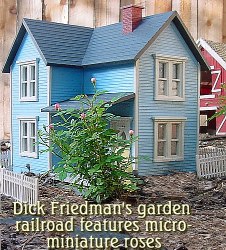 Reasons to Try New Things - Many gardeners who add trains to their gardens discover a hundred new plants to try that there was no "reason" to try before, not to mention different kinds of landscaping or water gardens or new ways of thinking about their gardens. As an example, my friend Dick Friedman, who had a garden for twenty-five years before he started his garden railroad, went out shopping for plants that wouldn't overwhelm his railroad. He discovered micro-miniature roses, which is on the verge of becoming a new hobby for Dick. In fact, I don't know a single person who has put a train in their garden (or back yard) that hasn't learned and become interested in a hundred new things.
Reasons to Try New Things - Many gardeners who add trains to their gardens discover a hundred new plants to try that there was no "reason" to try before, not to mention different kinds of landscaping or water gardens or new ways of thinking about their gardens. As an example, my friend Dick Friedman, who had a garden for twenty-five years before he started his garden railroad, went out shopping for plants that wouldn't overwhelm his railroad. He discovered micro-miniature roses, which is on the verge of becoming a new hobby for Dick. In fact, I don't know a single person who has put a train in their garden (or back yard) that hasn't learned and become interested in a hundred new things.
Dick Friedman, from the Sacramento, CA area says:
Where to begin! The most important new things I
learned were that plants grow faster than I imagined,
that trees are a blessing and a curse, that there's a
whole new world of near-enough-to-scale-sized plants.
I found that a pond enhances any garden, but
particularly when there's a train running 'round it!
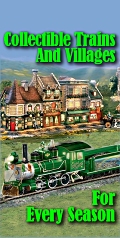 There were also a number of things that I never paid
much attention to in gardening that became much more
significant in garden railroading. One was tree leaves. Another:
the impact of bugs, particulary ants, who use the track
as a freeway, and snails/slugs who gum up track.
Lastly, I learned that the term "non-invasive" when
applied to plants means something like "probably won't
over run your railroad in under a week!" I like
ajuga, but since the weather turned warmer, it's
taking off (and over) growing horizontally about an
inch a week!
There were also a number of things that I never paid
much attention to in gardening that became much more
significant in garden railroading. One was tree leaves. Another:
the impact of bugs, particulary ants, who use the track
as a freeway, and snails/slugs who gum up track.
Lastly, I learned that the term "non-invasive" when
applied to plants means something like "probably won't
over run your railroad in under a week!" I like
ajuga, but since the weather turned warmer, it's
taking off (and over) growing horizontally about an
inch a week!
Brad Mugleston, of Aurora, Colorado says:
My "Garden Railroad" is in my flower garden which was planted to
be a flower garden that has trains in it. I've
got a large rose garden and have been trying to figure out how to
get track in there without either getting ripped apart by the
roses or having such sharp turns nothing will run.
Now I'm using the Garden excuse to add more trains to the back
yard - again I'm doing "Landscaping" to make the yard look nice
and so what if a few trains can run through there also?
I did most of the work last year so this is the first
year of really having a flower garden with the trains....
What I've learned so far this spring.
If you would like to add anything or correct anything in this article, please contact me.
In the meantime, best of luck,
Paul

| 
|
 |
 |
 |
 |
 |
Note: Family Garden TrainsTM, Garden Train StoreTM, Big Christmas TrainsTM, BIG Indoor TrainsTM, and BIG Train StoreTM are trademarks of Breakthrough Communications (www.btcomm.com). All information, data, text, and illustrations on this web site are Copyright (c) 1999, 2000, 2001, 2002, 2003, 2004, 2005, 2006, 2007, 2008, 2009, 2010, 2011, 2012, 2013 by Paul D. Race. Reuse or republication without prior written permission is specifically
forbidden.
Family Garden Trains is a participant in the Amazon Services LLC Associates Program, an affiliate advertising program designed to provide a means for sites to earn advertising fees by advertising and linking to amazon.com.
For more information, please contact us

 |  |